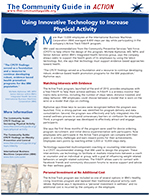Using Innovative Technology to Increase Physical Activity
Summary
 International Business Machines Corporation (IBM) used Task Force recommendations to help inform the design of its Active Track program. Employees who participate in the program can compete with their peers in activity challenges and earn reward points for their achievements. (Released 2015)
International Business Machines Corporation (IBM) used Task Force recommendations to help inform the design of its Active Track program. Employees who participate in the program can compete with their peers in activity challenges and earn reward points for their achievements. (Released 2015)Lessons Learned
- Integrate. Including options in an overall wellness process can help avoid confusion and unnecessary barriers for employees.
- Market. Creating an awareness campaign for new programs helps attract and engage employees.
- Match. Knowing your audience’s interests and motivations allows for better matching with evidence-based approaches toward health.
- Evaluate. Looking at a program’s process and outcomes not only allows for success to be measured, but also for future opportunities to be identified.
Story
IBM used recommendations from the Community Preventive Services Task Force (Task Force) to help inform the design of this program. Michele Alphonse, MD, MPH, and Senior Advisor within IBM’s Integrated Health Services group, says the company always seeks to support the health goals of its employees by using the latest technology. But, she says that technology must support evidence-based approaches toward health.
“The Task Force findings served as a foundation and a resource to continue developing robust, evidence-based health promotion programs for the IBM population,” Alphonse says.
Matching Interests with Evidence
The Active Track Program, launched at the end of 2013, provides employees with a free wearable device to help them achieve wellness. This device is a wireless monitor that tracks daily activities, including the number of steps taken, distance traveled, and sleep behavior. IBM employees could choose between a model that is worn on the wrist or a model that clips on clothing.
Alphonse says three keys to success were recognized before the program was launched. First, a strong partner was identified for program delivery and data consolidation. Second, the program was effectively and fully integrated into the overall wellness process to avoid unnecessary barriers or confusion for employees. Third, a program campaign was developed to effectively attract and engage participants.
She says the first three months of the program were used for device ordering, program recruitment, and initial device experimentation with participants. Now employees who participate in the Active Track Program can compete with their peers in activity challenges and earn reward points for their achievements. Employees earn points by reaching either 5,000 or 10,000 steps daily.
Technology-supported multicomponent coaching or counseling interventions (to reduce weight or maintain weight loss) is a Task Force recommended strategy that IBM used to design the program. These interventions use technology to facilitate or mediate interactions between a coach or counselor and an individual or group, with a goal of influencing weight-related behaviors or weight-related outcomes. The wearable device allows users to connect with Facebook friends and community discussion forums to receive support and advice for their wellness goals.
Personal Investment at No Additional Cost
The Active Track Program was included as one of several options in IBM’s Healthy Living Incentives program and replaced their traditional physical activity cash rebate. Alphonse says it represents a “personal investment in wellness” and no additional cost is incurred by the company or the employee.
“The Community Guide and Task Force findings are often an unknown, untapped, and under-utilized health resource to help leaders in U.S. organizations develop and justify the cost of health promotion programs with proven effectiveness and a definite ROI,” says Stewart Sill, Manager of Global Health and Vitality at IBM.
With the Active Track Program, employees choose among having incentives deposited into a health savings account, using their reward points to buy Amazon.com gift cards or other purchases, and making charitable donations.
Individually-adapted health behavior change programs are also recommended by the Task Force to increase physical activity and improve fitness among adults and children. The Active Track Program incorporates this recommendation by teaching employees how to use the wearable device to set individual goals and monitor their progress. It also builds social support for new behaviors when employees take activity challenges with their peers.
Encouraging Results
IBM’s initial findings show 96 percent of employees who chose the wearable have used it and 63 percent have linked it to the rewards platform. During the program’s first year, participants averaged 8,800 steps per day with individual averages of at least 5,000 steps for 120 days.
Employees admitted to choosing the Active Track Program because it was a new, refreshing alternative, and they liked wearing an activity tracker. Initial findings also discovered the following:
- 86 percent of employees said the device was easy to set up.
- 77 percent believed it would help them reach their individual health goals.
Alphonse says the program was so well received and adopted in the U.S. that IBM leaders in other countries have invested in similar programs. In 2014, IBM members took a total of 11,719,172,899 steps and walked approximately 5,859,586 miles. That was enough to take them to the Moon and back a total of 24.5 times.
Currently, IBM is comparing the physical activity of participants in the Active Track Program to nonparticipants and participants of other programs. In the future, the company plans to evaluate the quality of sleep measured by the wearable.
More Information
Community Preventive Services Task Force findings referred to in this story:
The Community Guide: Task Force Findings on Obesity Prevention and Control
- Obesity: Technology-Supported Multicomponent Coaching or Counseling Interventions To Reduce Weight
- Obesity: Technology-Supported Multicomponent Coaching or Counseling Interventions To Maintain Weight Loss
The Community Guide: Task Force Findings on Physical Activity